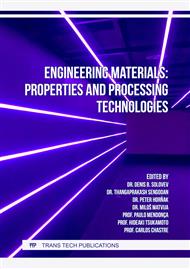p.201
p.209
p.215
p.221
p.227
p.234
p.240
p.248
p.254
Mechanical Properties of Sand-Cement Mortar with Different Water/Cement Ratio under Thermal Gradient Conditions
Abstract:
The paper studies the strength properties of sand-cement rod with the water-cement ratios of 0.4, 0.44, 0.49 and 0.54 under thermal gradient conditions. Experimental research concerns the influence of the temperature gradient within 60 to –20 оС on the mechanical properties of the sand-cement mortar with the different water-cement ratio. It is shown that the strength gain rate of sand-cement specimens varies in different periods of curing. The strength index of the sand-cement rod also varies in the conditions of heat and mass transfer that is supported by the theoretical background. The indicated temperature gradient significantly affects the curing process of the sand-cement specimens. Lower intensity of the strength gain is observed in specimens after 4-hour curing. The increase in the curing time from 8 to 12 hours leads to more intensive strength gain starting from the third specimen, when positive temperature begins. After 8-hour curing, the strength gain rate grows starting from the fifth specimen. At last, 12-hour curing results in the higher rate of the strength gain. Further increase in the curing time can lead to the highest strength gain rate. The rupture point drops with increasing water-cement ratio for all the specimens, independently of their position in the rod. Investigation of these processes will provide a better understanding of the negative effect of thermal gradient on the concrete structures and allow finding ways to increase their service life.
Info:
Periodical:
Pages:
227-233
Citation:
Online since:
March 2023
Authors:
Keywords:
Price:
Сopyright:
© 2023 Trans Tech Publications Ltd. All Rights Reserved
Share:
Citation:


